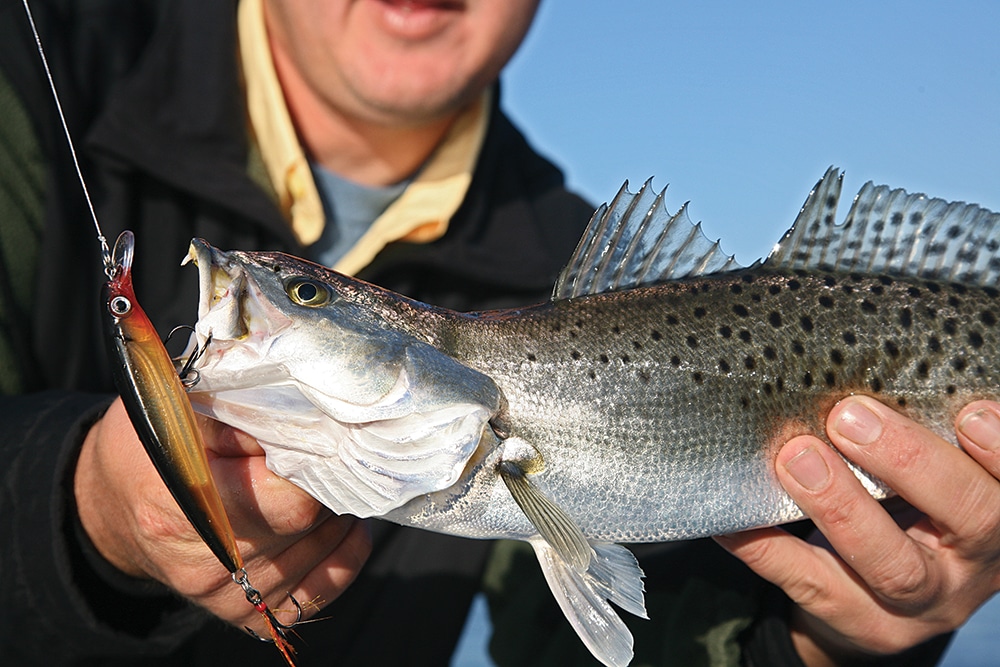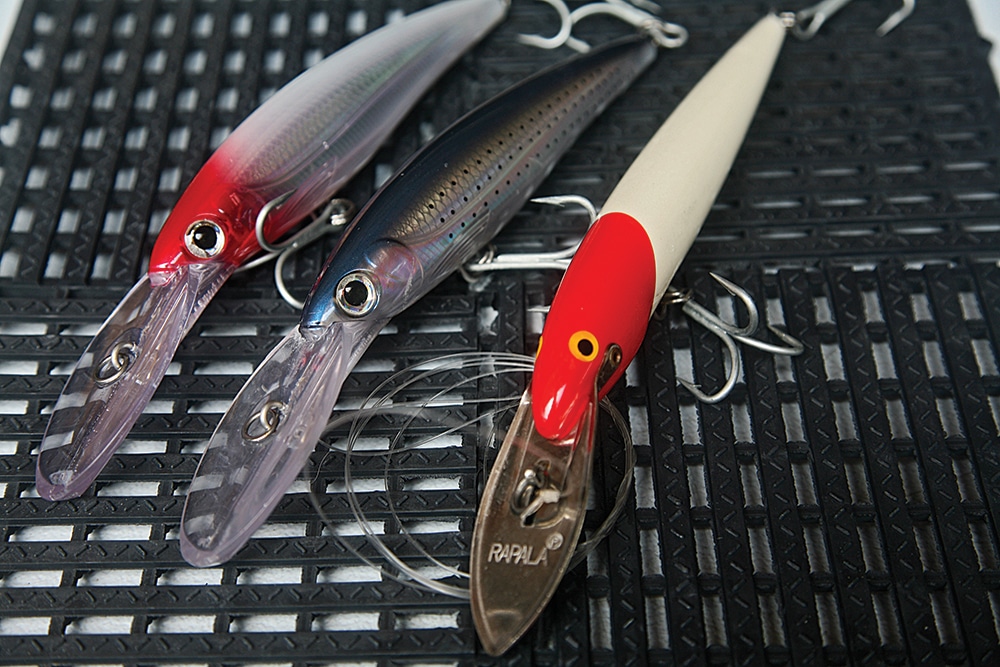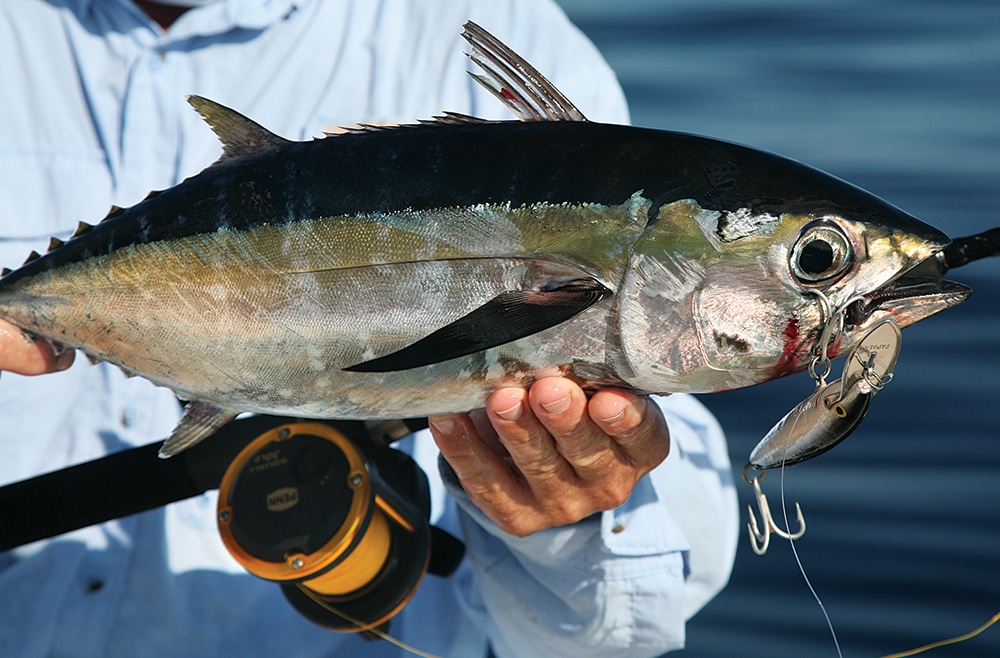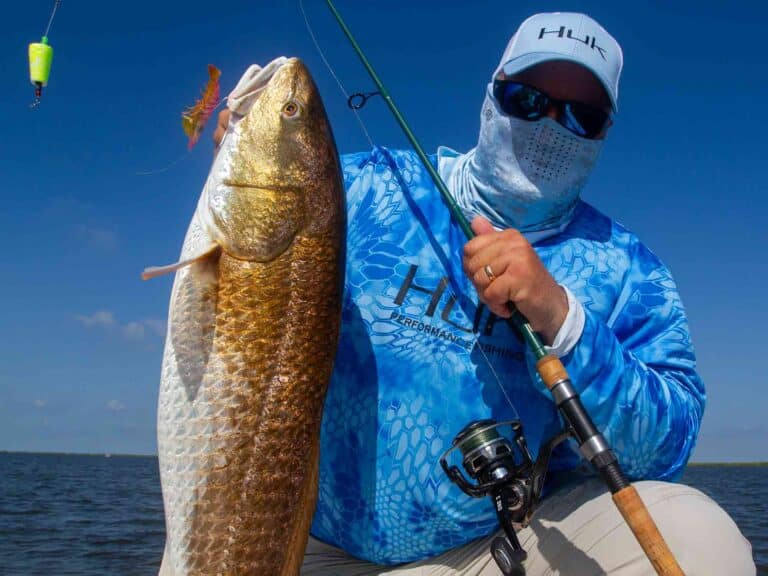
Click through the images in the gallery above.
Captain Blake Hayden is a master at catching speckled seatrout around Virginia Beach and in the Elizabeth River. Despite his notoriety as a live-baiter who has scored numerous monsters more than 10 pounds, we soaked very few livies when he and I got together this past December. Instead, we trolled a pair of Rapala X-Rap XR10 lures, and caught the heck out of these fish –– so many that we lost track of how many we released.
As simple as trolling swimming plugs might appear, it requires knowledge to be successful, including the subtle tricks Hayden employs, which we’ll get into later. The bottom line: Trolling swimming plugs is a great way to cover ground and score a wide range of game fish. I’ve taken wahoo, yellowfin and blackfin tunas, king mackerel, snook, tarpon, seatrout, and even groupers and snappers on them. Sometimes they’re better than live bait.
Dial In the Zone
When fish hold near bottom, or deep in the water column, towing a swimming plug near the surface won’t do much good. The inverse holds for fish near the surface, if you’re dragging a diving plug well beneath them.
Identify where your targeted game fish are likely to be and send the plug to them. Many times, the difference between success and failure is a few feet. Case in point: When I trolled CD18s through Haulover Inlet in Miami with snook guru David Justice, he’d let out enough line so the plug bumped bottom. Then he took a couple of turns on the reel handle to keep the plug just off the bottom, where it would get blasted by big snook. If that plug wasn’t swimming within three feet of the bottom, it went unnoticed.
It’s the same general rule trolling alongside bridges for snook, striped bass, groupers, and snappers and, of course, seatrout.
Hayden had us trolling channel edges and over mounds. We marked concentrations of bait and trout on our fish finder. We then dropped the lures back and down until they were in the ambush zone. We kept the rods out of the holders, as the upright positions changed the running attitude of the plugs, and raised them above the ambush zone. In the ambush zone, we pointed our rod tips at the surface. The line’s low angle of entry into the water minimized influence from wind, and kept the plugs parallel to the bottom. Once we approached a mound, we sped up to swim the plugs over them, or lifted the rods overhead and reeled up a few feet. The key to catching fish on the mounds was to keep the plug right above their contours, including the backsides — where several of the fish we caught were stationing — without snagging the bottom.
The Surface Warriors
One of my earlier experiences with trolling swimming plugs offshore dates back to the early 1980s and a Venice, Louisiana, wahoo trip I took with Capt. Mike Frenette. We were set to troll the fabled rip that materializes here, with our four Rapala CD 18s. Talk about an easy and not-so-fancy trolling setup! Frenette dispatched all four lures at staggered distances, and then watched them for a minute or two. He then took one that appeared to be swimming a tad off in one direction and moved the rods around until all the plugs were trolling straight in an attractive formation.
The wahoo blasted these lures, and we scored eight fish weighing up to 65 pounds before lunchtime, plus a few blackfins and even a yellowfin tuna. Trolling speeds were around 6 or 7 mph, and the plugs were set back so they swam within 10 feet of the surface.
At times, I’ll pull these same plugs for kingfish. And to get them even deeper, I use a trolling sinker, attaching the plug to a 10- to 15-foot section of 86-pound-test single-strand wire leader, with a snap swivel at the opposite end. I add an 8-ounce, and sometimes 16-ounce, trolling sinker between the snap swivel on the fishing line and the leader. This gives me depth, and the ability to troll fast and keep the plug in the water.
Many swimming plugs now have elongated and wider diving lips to reach depths approaching 50 feet, models often ideal for grouper trolling. Yet, they do exert excessive drag and require stout tackle. If you wish to use lighter tackle but reach excessive depths, downriggers and high-speed planers get the job done with smaller-lipped plugs. Hayden swears his most productive plugs have orange in them, whether they’re stripes, gills or bellies. While I’m sure color matters, I like to play off nature.
Color Me Caught?
I prefer plugs that mimic the size and color of the local forage. Fish commonly get selective and binge on a specific bait. To score, you’d better match up your lure to that species.
The standard white body/red head (like we used for wahoo off Venice, Louisiana, and a favorite inlet plug color for snook) can resemble a mullet, ladyfish, hard tail or other bait that’s injured and bleeding. Fish also sometimes strike out of instinct — not hunger. And that’s fine when you’re trying to feed them some treble hooks.
And on the subject of hooks, when pulling plugs on heavy tackle (50-pound class) for big fish like wahoo, loosen the drag some, or risk straightening the hooks. Or change out the trebles for a pair of strong J-hooks.
Tease ’Em!
Although our plugs swam through prime ambush zones, Hayden continually worked the rod. He whipped it forward a few feet, dropped the rod to create slack, and then let the forward motion of the boat pull it taut again. He raised the rod a bit when he did this, then lowered it and repeated that action. His philosophy: It makes the plug appear injured and panicked, which predators see as an easy meal. He explained that many trout ambush the plug during that brief, seconds-only pause when he drops the rod back. And was he ever right — we took a bunch during that pause.
We also converted those short strikes by dropping back and letting the plug suspend for a few extra seconds; if they weren’t eaten on the fall, we twitched, reeled and dropped the plug back a few times rapidly. That often sealed the deal.
Unlike natural trolling baits, or even live baits, swimming plugs require neither painstaking rigging nor time to derig. Nor do you have to find them, net them and keep them frisky. Yet, like both natural and live baits, swimming plugs catch the heck out of fish. Some days, these low-maintenance lures can’t be topped. Just ask Capt. Blake Hayden.
Eight Swimming-Plug Trolling Tips
1 When fishing structure, aim the rod tip at the water to maximize the plug’s running depth.
2 Even though some plugs have a ring to tie to, use a loop (haywire twist with wire, and overhand loop knot with mono and fluorocarbon) when securing the leader; this gives the plug that much more latitude to swim freely.
3 Spool with braid, as the thin diameter cuts through the water, helping plugs achieve their depth potential.
4 Transom- or reel-seat release clips are ideal for pulling swimming plugs from flat lines when offshore fishing. This reduces the angle of entry of lines going into the water, and helps keep plugs down in the water column, running a little deeper.
5 Don’t be afraid to use single-strand wire leader when trolling inlets or areas with heavy current. The thin diameter of the wire helps cut through the water efficiently, and chances are the fish won’t notice it, especially in cloudy water.
6 Incorporate a swivel when trolling plugs — especially with spin tackle — to prevent line twist.
7 When trolling over structure near schooling fish, add action to the lures by jerking them back and pausing to let them suspend, regardless of how brief the lull. Make that plug look injured and panicked.
8 When using heavy tackle, consider replacing the stock treble hooks with extra-strength ones or single J-hooks. Or simply back off the drag a bit.












